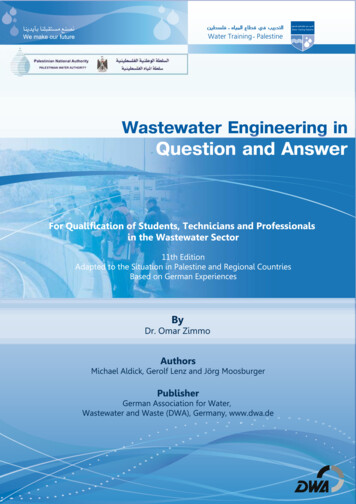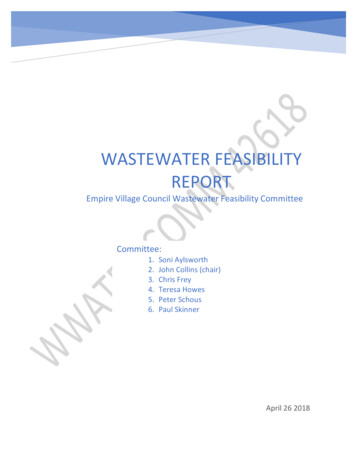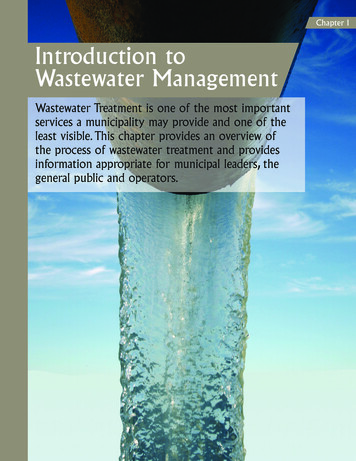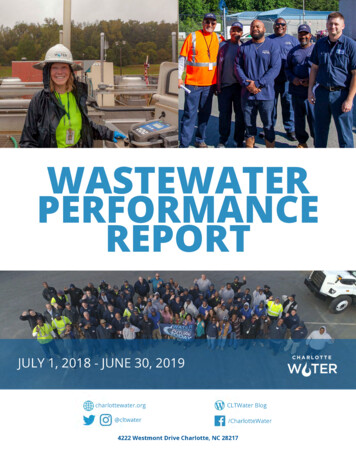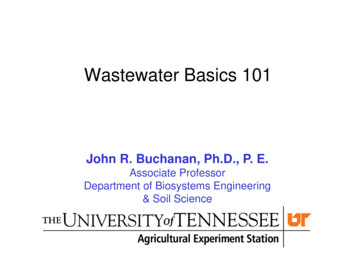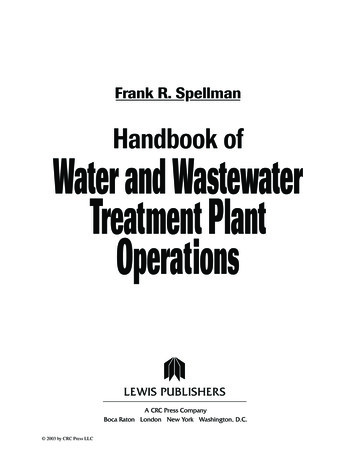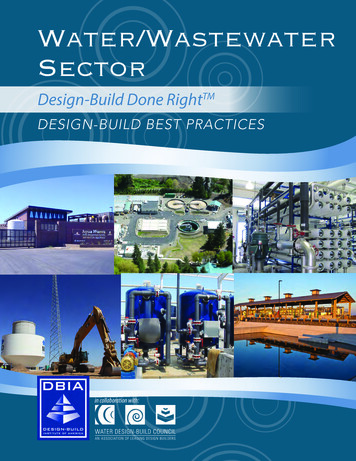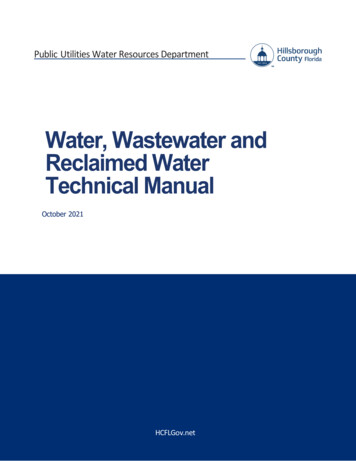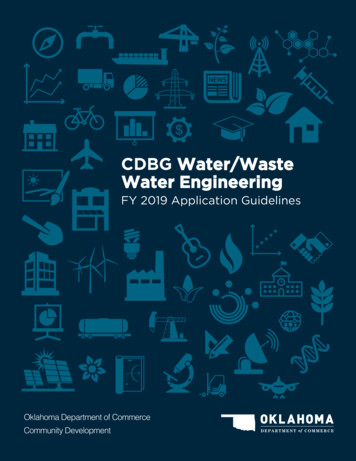
Transcription
Community Development Block GrantsWater Wastewater EngineeringApplication & GuidelinesPublished January 2022
State of OklahomaTable of ContentsSECTION ONE: APPLICATION GUIDANCE . 3National Objective-CDBG Funds . 4Eligible Entities . 4Application Submission Requirements . 5Proper Sponsors . 5CDBG Water/Wastewater Engineering Projects – Use of Funds . 5Project Definition . 6Leverage. 6CDBG Project Eligibility Policy . 6SAM.Gov Debarred / Exclusion Check Requirement . 7Proposal Guidance . 9SECTION TWO: REQUIRED DOCUMENTATION . 101. Application Summary and Certification (OKGrants – Online Completion Only) . 102. Detailed Line Item Budget (OKGrants – Online Completion Only) . 103. Water/Wastewater Rate Structure (OKGrants – Online Completion Only) . 104. Consultant Form (OKGrants – Online Completion Only) . 105. Audit (OKGrants – Online Completion Only) . 106. Applicant Resolution (Attachment A – Upload to OKGrants) . 117. Citizen Participation Requirement (Attachment B – Upload Form to OKGrants) . 118. Certified Engineering Report & Professional Cost Estimates (Attachment C – Upload to OKGrants). 139. Leverage (Attachments D1, D2, D3 – Upload Forms to OKGrants) . 1610. LMI Documentation (Attachment E – Upload to OKGrants) As Applicable . 17(a) Qualifying under the National Objective of Benefit to Low and Moderate-Income Person. 17(b)Conducting an Income Survey . 1811. W-9 Form & Instructions (Attachment F – Upload to OKGrants). 2012. Severity of Need Documentation (Attachment G – Upload to OKGrants) . 20Table of Contents12022 W/W Engineering
State of Oklahoma13. SAM.gov Exclusion / Debarment Verification (Attachment H – Upload to OKGrants) . 2114. Water / Wastewater Rate Verification Documentation (Attachment I – Upload Form to OKGrants) 21SECTION THREE: THRESHOLD CRITERIA . 22Threshold Criteria for CDBG Water/Wastewater Engineering Set-aside . 22SECTION FOUR: APPLICATION RATING CRITERIA. 25Rating Criteria for CDBG Water/Wastewater Engineering . 25ATTACHMENTS: A – JAPPENDICES:Appendix A:Direct Project Beneficiary Income Survey Field WorksheetAppendix B:LMI Table DefinitionsAppendix C:HUD OK Low and moderate-income Percentages by County / Town / CityAppendix D:HUD Income Limits
State of OklahomaSECTION ONE:APPLICATION GUIDANCEThe purpose of this Application Guide is to provide guidance in preparing a CommunityDevelopment Block Grant (CDBG) Water/Wastewater Engineering application for the OklahomaDepartment of Commerce / Community Development (ODOC/CD). The primary goals of theCDBG Water/Wastewater Engineering Program are to (1) ensure the most proper technicalsolutions to the applicant’s water and wastewater problems within the budget that is available;and (2) improve coordination among other state agencies (both permitting and financing). It isimportant to note that given the design and intent of the State’s CDBG Water/WastewaterEngineering Program, an eligible application must contain an engineering component regardlessof whether CDBG or leveraged funds are paying for this cost.NOTE: STARTING BACK WITH THE 2019 PROGRAM YEAR CDBG APPLICATIONS, theformer CDBG Water/Wastewater Engineering Phase I and CDBG Water/Wastewater PhaseII Programs have been merged into one single program. This new program will be knownas “CDBG Water/Wastewater Engineering” and will use a single application to allow forboth engineering and construction.Applicants submitting under the CDBG Water/Wastewater Engineering Program may elect toeither have (1) CDBG funds pay for the engineering, construction, administration, permitting, andother costs associated with water/wastewater project; or (2) provide a combination of CDBG fundsand other funds to pay for these costs.Applicants who successfully compete under the CDBG Water/Wastewater EngineeringProgram and receive an award that will be subject to the following project timeline.Prospective applicants should note that this timeline will be strictly enforced by ODOC/CDin order to ensure the timeliness of CDBG expenditures as required by the U.S. Departmentof Housing and Urban Development (HUD). CDBG Water/Wastewater awardees will receivea three (3) year contract structured as follows:A. Year One – The subgrantee will be required to successfully complete projectengineering and achieve Release of Funds within one (1) year. ODOC/CD will carefullymonitor project activity and subsequent progress. Allowable engineering costs will bebased on the U.S. Department of Agriculture Rural Development (USDA-RD) sliding scale.Once the Oklahoma Department of Environmental Quality (ODEQ) permit and OklahomaDepartment of Commerce/Community Development (ODOC/CD) Release of Fundsrequirements are complete (regardless of the source of funds), the subgrantee will be able toproceed with project construction.(1) If the above deliverables are not met, the contract will be subject to deobligation byODOC/CD.(2) As part of ODOC/CD’s monitoring and evaluation of the project’s engineering progress,the subgrantee must submit all required documentation as outlined in the CDBG ProjectManagement Guide (https://okcommerce.gov/community/cdbg/) or as otherwise directed bythe CDBG Project Manager to ODOC/CD in a timely manner. Failure to submit any or allrequired documentation will result in contract deobligation.Section One32022 W/W Engineering
State of Oklahoma(3) Should the contract be deobligated, any expended CDBG funds will be required to bereimbursed by the subgrantee. The contract will remain open until repayment is made duringwhich time the subgrantee will not be eligible to apply for additional CDBG funding.(4) An ODOC/CD review committee will determine deobligation of the CDBG funding if theproject’s engineering has NOT been satisfactorily completed and Release of Funds has NOTbeen obtained. This review committee will be composed of ODOC/CD staff to include: CDBGPlanners, the Director of Programs (Planning & Monitoring), and the Division Director.(5) If a subgrantee is deobligated “in good standing” without any CDBG funds expended orhas made the proper CDBG repayment as deemed necessary, the subgrantee could closethe contract and reapply during the next year’s application cycle.B. Years Two & Three – Project construction will be allowed for a period of two (2) years plusany time left available should the engineering and Release of Funds be accomplished beforethe one (1) year engineering limit is reached.The grant maximum for the CDBG Water/Wastewater Engineering application is 600,000. Themaximum amount of CDBG Water/Wastewater Engineering funds that may be used for ActivityDelivery Cost (e.g. CDBG Administrator) is eight percent (8%) of the total CDBGWater/Wastewater Engineering funds awarded for the total construction and professional/nonconstruction funds provided. All CDBG Water/Wastewater Engineering applications must bereceived no later than May 3, 2022. Applications received after this date will NOT be consideredfor funding.Applicants are required to complete and submit their respective application and applicableattachments online at the following OKGrants web address: https://grants.ok.gov. NO PAPERAPPLICATIONS WILL BE ACCEPTED. Application guidelines containing the specific programrequirements for the CDBG Water/Wastewater Engineering application is available onODOC/CD’s website: https://www.okcommerce.gov/community-development/. WARNING:Prospective applicants should review the application guidance BEFORE attempting tocomplete the online application. Failure to meet application guidelines or properly submitrequired application documentation may result in a FAILED or DENIED application rating.National Objective-CDBG FundsThe primary National Objective of the Community Development Block Grant (CDBG) Program isthe “development of viable urban communities by providing decent housing and a suitable livingenvironment, particularly for persons of low and moderate-incomes.” The use of the “benefit tolow and moderate-income-persons” CDBG National Objective is considered a funding PRIORITYunder the State’s CDBG Program and is treated as such under the State’s individual CDBG setasides. All project proposals submitted for funding through the State’s CDBG Program mustdocument the achievement of the low and moderate-income National Objective as delineated in24 CFR §570.483 (Criteria for National Objectives). Provide benefit to low and moderate-income persons.Eligible EntitiesEligible applicants for the CDBG Water/Wastewater Engineering Program are units of localgovernment (incorporated towns, cities, and counties) that are not participants in the CDBGEntitlement Program. Oklahoma’s entitlement cities are Edmond, Enid, Lawton, Midwest City,Moore, Norman, Oklahoma City, Shawnee, and Tulsa as well as the units of local governmentSection One42022 W/W Engineering
State of Oklahomaparticipating in the CDBG Urban County Designation for Tulsa County which consists of thefollowing:City of BixbyCity of Broken ArrowCity of CollinsvilleCity of GlenpoolCity of JenksCity of OwassoCity of Sand SpringsCity of SapulpaCity of SkiatookTown of SperryUnincorporated Tulsa CountyApplication Submission Requirements1. City/Town and County (Direct Jurisdiction) Applicants: City/Towns and Counties receivinga direct jurisdictional benefit may submit only one (1) grant application per CDBGProgram Year selecting from CDBG Water/Wastewater Engineering, CDBGWater/Wastewater Construction, CDBG Community Revitalization, or CDBG Rural EconomicAction Plan (REAP). A City/Town and County (Direct Jurisdiction) cannot submit a CDBGapplication if it currently has an open CDBG grant. Exclusions: Economic DevelopmentInfrastructure Financing (EDIF) and Capital Improvement Planning (CIP). Typical Countydirect jurisdiction CDBG application projects are roads, bridges, County hospital, etc.2. County Sponsored Applicants: Counties acting in a “sponsorship” capacity may submit amaximum of one sponsored CDBG grant application per CDBG Program Year selecting fromWater/Wastewater Engineering, Water/Wastewater Construction, Community Revitalization,or Rural Economic Action Plan (REAP). Limitation: Counties may ONLY have one (1) opensponsored CDBG grant and still make another sponsored CDBG application. Countiescannot exceed a maximum number of two (2) open sponsored CDBG grants open atany given time. Exclusions: Economic Development Infrastructure Financing (EDIF) andCapital Improvement Planning (CIP). Counties may sponsor applications where they do nothave direct jurisdiction over certain public functions. Generally, these are communities withless than 25,000 in revenue, Rural Water Districts, and Rural Fire Districts.Proper SponsorsThe process of determining which unit of government (a town, city or county) should submit orsponsor an application for CDBG Water/Wastewater Engineering assistance must include anexamination of the relationship between the location of proposed improvements in the servicedelivery area, and the proposed beneficiaries. The unit of government with direct jurisdiction overthe majority (60%) of the proposed beneficiaries must be the sponsor or applicant for CDBGWater/Wastewater Engineering funds. However, in the event that no unit of local government has60% of the proposed beneficiaries, then the unit of local government with the majority of proposedbeneficiaries must sponsor the application for grant assistance. Also, in some instances a countymay submit an application on behalf of a town or city that cannot meet the minimum 25,000annual revenue financial requirements identified in the Threshold Requirements in this guide.Prospective applicants are advised to contact ODOC/CD BEFORE application submissionregarding any questions relating to proper sponsorship should any additional clarification berequired.CDBG Water/Wastewater Engineering Projects – Use of FundsAll projects shall be single purpose, either water or wastewater that will focus on some of the mostserious problems in the state. Eligible applicants submitting under the Engineering competitiveprogram may elect to either have (1) CDBG funds pay for the engineering, administration andother costs associated with securing a construction permit with the Oklahoma Department ofEnvironmental Quality (ODEQ); (2) may choose other sources of funds to pay for these costs; orSection One52022 W/W Engineering
State of Oklahoma(3) provide a combination of CDBG Water/Wastewater Engineering funds and other funds to payfor these costs.Project DefinitionUnder the State’s CDBG Water/Wastewater Engineering program, a project is defined as ONEeligible or sponsored unit of local government (UGLG) applying for ONE activity in which there isa benefit to only ONE geographically TARGETED AREA or an entire COMMUNITY-WIDE AREA.These areas allow for an activity in which only ONE LMI survey (as applicable) is required. If theproject doesn’t meet the above definition it will be disqualified resulting in a FAILED applicationrating.LeverageThe State’s CDBG Program requires that all leveraged CDBG project funding be in place at thetime of the application submission. There are several reasons for this. First, the HUD based CDBGProgram imposes program specific obligation and expenditure requirements. Most importantly,an applicant may simply not receive the leveraged funding as intended. This is an inefficient useof valuable CDBG program time and requires additional ODOC/CD staff time to deobligate thecontract and reallocate the contract funding to another eligible CDBG project. Second, applicantswithout secured leverage funding at the time of the application submission would requireadditional time for securing the funds adding time to the overall project completion timeline. Third,there is no foreseeable way to impose an additional timeframe for the allowance to secureleveraged funding that would be fair to all applicants given the varied types of outside fundingavailable.CDBG Project Eligibility PolicyProspective CDBG Program applicants are strongly encouraged to review (24 CFR 570 SubpartsA, C, I, K, and O) of the Electronic Code of Federal Regulations (https://ecfr.io/Title-24/) foradditional regulatory CDBG Program guidance as related to State CDBG Programs. The Housingand Community Development Act Section 105(a) and 24 CFR 570.482 defines eligible activitiesunder the State CDBG Program. While some regulatory language is direct, there are instanceswhere more clarity is needed.It is the policy of ODOC/CD that should a prospective CDBG Program applicant request a CDBGproject/activity that does NOT appear directly eligible and cannot be immediately determined asineligible as interpreted from CDBG regulatory guidance and ODOC/CD staff that the applicantcan formally request ODOC/CD to seek a final determination from HUD officials.a. The prospective applicant will be required to submit a project/activity narrative regardingthe requested activity. This will be required by HUD to conduct their review and make adetermination. It is the responsibility of the prospective applicant to provide the narrative.The submission of the narrative to ODOC/CD will be seen as the formal request to seeka final determination from HUD.b. Once a detailed project narrative is received by ODOC/CD, it will be submitted to theOklahoma City HUD office for a final eligibility determination.Prospective applicants are advised to seek project/activity guidance as soon as possible fromODOC/CD if they have eligibility concerns. Prospective applicants should be aware that finalSection One62022 W/W Engineering
State of OklahomaCDBG regulatory and program guidance can take several months to receive from HUD.ODOC/CD understands that prospective applicants are subject to CDBG application deadlines;however, in absence of a final project/activity determination from HUD, ODOC/CD cannot allowan award for any requested CDBG project/activity that cannot be determined to be directly CDBGeligible. If the project/activity eligibility determination hasn’t been received from HUD by the CDBGapplication deadline, the application will receive a FAIL threshold rating. Applicants are advisedto consider that a determination may not be received by the CDBG application submission date.SAM.Gov Debarred / Exclusion Check RequirementThe System for Award Management (SAM) is an official website of the U.S. government. Youmust have an active registration in SAM to do business with the Federal Government. Thereis no cost to use SAM. The General Services Administration (GSA) is required by the FederalAcquisition Regulation (FAR) to compile and maintain a list of parties debarred, suspended, ordisqualified by federal agencies in SAM.gov. Units of General Local Government (UGLG’s),contractors as well as recipients of federal financial assistance must be registered at SAM.gov.Active registration in SAM is required to apply for an award and for HUD to make a payment. ByApril 4, 2022, the Federal government will transition away from the use of the DUNS Number andtoward the new Unique Entity ID as the primary means of entity identification for Federal awardsgovernment-wide. If you are registered in SAM.gov, you’ve already been assigned a new UniqueEntity ID! It’s viewable in your SAM.gov entity registration record. Go to fsd.gov and select thegreen Help on UEI Transition button to learn more.ODOC/CD is required by HUD to check UGLG grantees’ debarment/exclusion status in thefederal SAM database and place a record on file. You can use this site for FREE to: Register to do business with the U.S. governmentUpdate or renew your entity registrationCheck status of an entity registrationSearch for entity registration and exclusion recordsPer the SAM User Guide, the No Active Exclusions field on the SAM Entity summary indicateswhether the entity has a current debarment. SAM.gov will check the exclusions list for the DUNSnumber of your entity and indicate whether any exclusion records exist. If an active exclusionrecord exists for your entity, this question will default to “Yes,” meaning that the contractor isdebarred. No Record Found means that the entity is not registered or has let its registration lapse.The entity should ensure that the email address is current in SAM.gov so that when automatedreminders are sent to renew registration each year that this reminder does not go into spam dueto an obsolete email address.How do I start a SAM registration? If you have not yet started your registration, pleasecreate an individual user account and log into SAM to register your entity. To register in SAM,at a minimum, you will need the following information:U.S. REGISTRANTS:Section One72022 W/W Engineering
State of Oklahoma1. Your DUNS Number, Legal Business Name, and Physical Address from your Dun& Bradstreet (D&B) record. If you don't already have one, you can request a DUNSNumber for FREE from Dun & Bradstreet (D&B).2. Your Taxpayer Identification Number (TIN) and Taxpayer Name associated withyour TIN. Review your tax documents from the IRS (such as a 1099 or W-2 form) tofind your Taxpayer Name.3. Your bank's routing number, your bank account number, and your bank accounttype, i.e. checking or savings, to set up Electronic Funds Transfer (EFT).If you already started your registration, check your status by entering your DUNS Number orCAGE Code in the SAM Status Tracker. You will be required to upload the PDF copy providedwhich the check which shows that the UGLG is NOT excluded into OKGrants.SAM.Gov Website Exclusion Check – NOTE: CONDUCT A PUBLIC SEARCH. DO NOTLOG INTO SAM.Gov. This will ensure that the information is available for PUBLIC review.Choose “Search Records” and then use “Quick Search” Enter the UGLG’s nine digit DUN’snumber in the “DUNS Number Search” field. Select the “SEARCH” button the bottom of thepage.Save a copy of the search by selecting the “Save PDF” button at the top of the box. This willprovide the electronic PDF file copy needed to be uploaded into the CDBG application inOKGrants.Section One82022 W/W Engineering
State of OklahomaProposal GuidanceTechnical assistance regarding eligible projects, project concepts, the application guidelines, andother information pertaining to the CDBG Water/Wastewater Engineering Program is availableupon request.Applicants are encouraged to contact the staff persons listed below anytime they are uncertainwith regard to program requirements, project conceptualization, or any portion of the applicationpacket and/or guidelines.CDBG Water/Wastewater Engineering Application inquiries may be directed to:Charlotte Conant, 405-215-1834 or charlotte.conant@okcommerce.govSection One92022 W/W Engineering
State of OklahomaSECTION TWO: REQUIRED DOCUMENTATIONThe following narration provides detailed guidance regarding the documents needed to submit acomplete CDBG Water/Wastewater Engineering application. Please note that the documentationin items One (1) through Five (5) can only be completed online at the OKGrants’ website. ItemsSix (6) through Fourteen (14) are attachments that are required to be completed and thenelectronically uploaded via the internet to the OKGrants’ website.1. Application Summary and Certification (OKGrants – Online Completion Only)The summary requests general information about the applicant and must be completed in full.The certification attests to the accuracy and completeness of the application.2. Detailed Line Item Budget (OKGrants – Online Completion Only)The proposed activities should be detailed because they will provide the basis of your contractand project budget should you receive funding.Costs incurred as a direct result of implementing and executing eligible CDBG activities such asthose activities listed under 24 CFR 570.201-204 and 24 CFR 570.206 are known as “ActivityDelivery Costs”. These costs are directly attributable to an eligible CDBG project activity. Underthe State’s CDBG Community Water/Wastewater Engineering set-aside, the maximum amountof CDBG funds that may be used for Activity Delivery Costs by a CDBG certified administratoris eight percent (8%) of the total CDBG construction and professional/non-construction fundsprovided.Requirements for Serving New Housing Developments: Applicants requestingWater/Wastewater system expansions serving new housing development must include on theirDetailed Line Item Budget all sources of financing (infrastructure and housing development).Speculative projects will not be accepted.3. Water/Wastewater Rate Structure (OKGrants – Online Completion Only)Water/Wastewater rate structures must favor both strong fiscal management and conservationmeasures. Rate structures will be analyzed and awarded points by using portions of the “WaterResources Board’s Emergency Grant Priority System.” The “Total Water and Sewer Rate” sectionis ONLY for operators supplying customers with BOTH Water & Sewer. Applications will receivepoints based on the first 5,000 gallons only!4. Consultant Form (OKGrants – Online Completion Only)5. Audit (OKGrants – Online Completion Only)TOWNS AND CITIES (COUNTIES ARE EXEMPT) MUST SUBMIT A COPY OF THEIR AUDITOR THE AGREED UPON PROCEDURES BY THE APPLICATION DEADLINE. ALL TOWNSAND CITIES THAT HAVE A JUNE 30, FISCAL YEAR END DATE ARE REQUIRED TO SUBMITA COPY OF THEIR FY 2021 AUDIT AND TOWNS AND CITIES THAT HAVE A DECEMBER 31,FISCAL YEAR END DATE ARE REQUIRED, AS A MINIMUM, TO SUBMIT A COPY OF THEIRFY 2020 AUDIT. NO APPLICATION WILL BE CONSIDERED FOR REVIEW OR FUNDING THATDOES NOT MEET THE REQUIREMENTS STATED ABOVE.If the city or town receives less than 25,000 in annual revenues from its normal business anddoes not have an audit or agreed upon procedure, the city or town cannot apply directly toSection Two102022 W/W Engineering
State of OklahomaODOC/CD. The city or town can apply only by having the local County apply on their behalf, ifthe County chooses to do so.An audit is required to be uploaded as part of the application process. Alternatively, the audit mayalso be submitted via postal mail to:Oklahoma Department of CommerceAdministrative ServicesAttn: Sharmin Rahman900 N. Stiles Ave.Oklahoma City, OK 73104General audit inquiries and questions regarding audit submissions should be directed to SharminRahman at the Oklahoma Department of Commerce.Sharmin Rahman, 800-879-6552, ext. 5312 or 405-815-5312(sharmin.rahman@okcommerce.gov)6. Applicant Resolution (Attachment A – Upload to OKGrants)Applications must include a resolution passed by the current governing body requesting thatparticular assistance. The Resolution is required to be uploaded as part of the applicationprocess. A sample resolution is provided in Attachment “A” of the application. The Resolution isrequired to be signed and dated by the chief elected official. The Resolution also requires aTown/City/County seal or it must be notarized in lieu of the seal.7. Citizen Participation Requirement (Attachment B – Upload Form to OKGrants)All applicants, in order to apply for CDBG assistance, must complete and document the followingrequirements: (1) create and adopt a Written Citizen Participation Plan and (2) hold an applicationphase public hearing regarding the CDBG Water/Wastewater Program.Citizen Participation Plans must be officially adopted and followed by all applicants and submittedas Attachment “B” in the application. Re-stating the Citizen Participation Plan outlinerequirements does not constitute a valid plan. Applicants must clearly state the actions they willundertake to meet the requirements of Written Citizen Participation Plans. (Sample CitizenParticipation Plan can be found in the Attachment “B” of the application.) Applicants may readoptprior years Citizen Participation Plans provided that the previous plan has been reviewed andupdated as needed to adequately support the proposed project.Documentation of the “application phase” Public Hearing is also an application requirement.Acceptable documentation consists only of the affidavit of publication, official postingannouncing where and when the hearing is to be held along with a listing of the postinglocations (posting is an acceptable method of advertising only where it is the standard methodused by a unit of local government to provide notice of official meeting), or a copy of thenewspaper article announcing the public hearing.ODOC/CD requires that no less than seven (7) working days be given as advance notice of theapplication phase Public Hearing or any subsequent public meetings held for the purpose ofdiscussing project activities as they relate to the CDBG Water/Wastewater Engineering grantfunds.Section Two112022 W/W Engineering
State of OklahomaAll written Citizen Participation Plans must explain how an applicant unit of local government will:1. Provide for and encourage citizen participation, particularly by low and moderate-incomepersons who reside in areas where CDBG Water/Wastewater Engineering funds areproposed to be used.2. Ensure citizens will be given reasonable and timely access to local meetings, information andrecords relating to the unit of local government's proposed and actual use of the CDBGWater/Wastewater Engineering funds, including, but not limited to, the following:(a) The amount of CDBG Water/Wastewater Engineering funds expected to be madeavailable for the current fiscal year if the project is approved;(b) The range of activities that may be undertaken with CDBG Water/WastewaterEngineering funds;(c) The estimated amount of CDBG Water/Wastewater Engineering funds proposed to beused for activities that will meet the National Objective of benefit to low an
The grant maximum for the CDBG Water/Wastewater Engineering application 600,0is 00. The maximum amount of CDBG Water/Wastewater Engineering nds that may be used for Activity fu Delivery Cost (e.g. CDBG Administrator) is eight percent (8%) of the total CDBG Water/Wastewater Engineering funds
